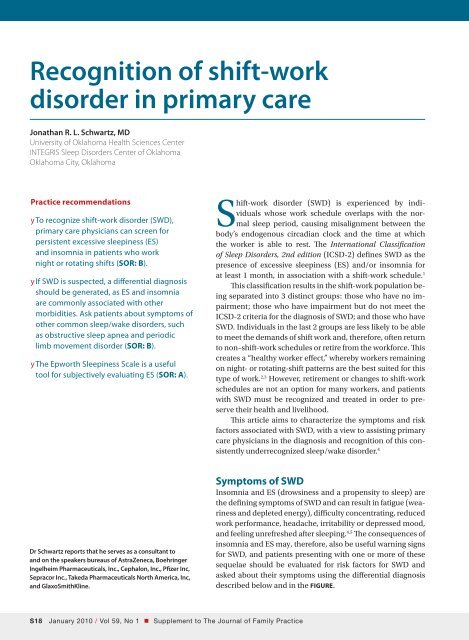SHIFT WORK DISORDER - myCME.com
SHIFT WORK DISORDER - myCME.com
SHIFT WORK DISORDER - myCME.com
- No tags were found...
Create successful ePaper yourself
Turn your PDF publications into a flip-book with our unique Google optimized e-Paper software.
Recognition of shift-workdisorder in primary careJonathan R. L. Schwartz, MDUniversity of Oklahoma Health Sciences CenterINTEGRIS Sleep Disorders Center of OklahomaOklahoma City, OklahomaPractice re<strong>com</strong>mendationsy To recognize shift-work disorder (SWD),primary care physicians can screen forpersistent excessive sleepiness (ES)and insomnia in patients who worknight or rotating shifts (SOR: B).y If SWD is suspected, a differential diagnosisshould be generated, as ES and insomniaare <strong>com</strong>monly associated with othermorbidities. Ask patients about symptoms ofother <strong>com</strong>mon sleep/wake disorders, suchas obstructive sleep apnea and periodiclimb movement disorder (SOR: B).y The Epworth Sleepiness Scale is a usefultool for subjectively evaluating ES (SOR: A).Shift-work disorder (SWD) is experienced by individualswhose work schedule overlaps with the normalsleep period, causing misalignment between thebody’s endogenous circadian clock and the time at whichthe worker is able to rest. The International Classificationof Sleep Disorders, 2nd edition (ICSD-2) defines SWD as thepresence of excessive sleepiness (ES) and/or insomnia forat least 1 month, in association with a shift-work schedule. 1This classification results in the shift-work population beingseparated into 3 distinct groups: those who have no impairment;those who have impairment but do not meet theICSD-2 criteria for the diagnosis of SWD; and those who haveSWD. Individuals in the last 2 groups are less likely to be ableto meet the demands of shift work and, therefore, often returnto non–shift-work schedules or retire from the workforce. Thiscreates a “healthy worker effect,” whereby workers remainingon night- or rotating-shift patterns are the best suited for thistype of work. 2,3 However, retirement or changes to shift-workschedules are not an option for many workers, and patientswith SWD must be recognized and treated in order to preservetheir health and livelihood.This article aims to characterize the symptoms and riskfactors associated with SWD, with a view to assisting primarycare physicians in the diagnosis and recognition of this consistentlyunderrecognized sleep/wake disorder. 4Dr Schwartz reports that he serves as a consultant toand on the speakers bureaus of AstraZeneca, BoehringerIngelheim Pharmaceuticals, Inc., Cephalon, Inc., Pfizer Inc,Sepracor Inc., Takeda Pharmaceuticals North America, Inc,and GlaxoSmithKline.Symptoms of SWDInsomnia and ES (drowsiness and a propensity to sleep) arethe defining symptoms of SWD and can result in fatigue (wearinessand depleted energy), difficulty concentrating, reducedwork performance, headache, irritability or depressed mood,and feeling unrefreshed after sleeping. 4,5 The consequences ofinsomnia and ES may, therefore, also be useful warning signsfor SWD, and patients presenting with one or more of thesesequelae should be evaluated for risk factors for SWD andasked about their symptoms using the differential diagnosisdescribed below and in the Figure.S18 January 2010 / Vol 59, No 1 • Supplement to The Journal of Family Practice
















